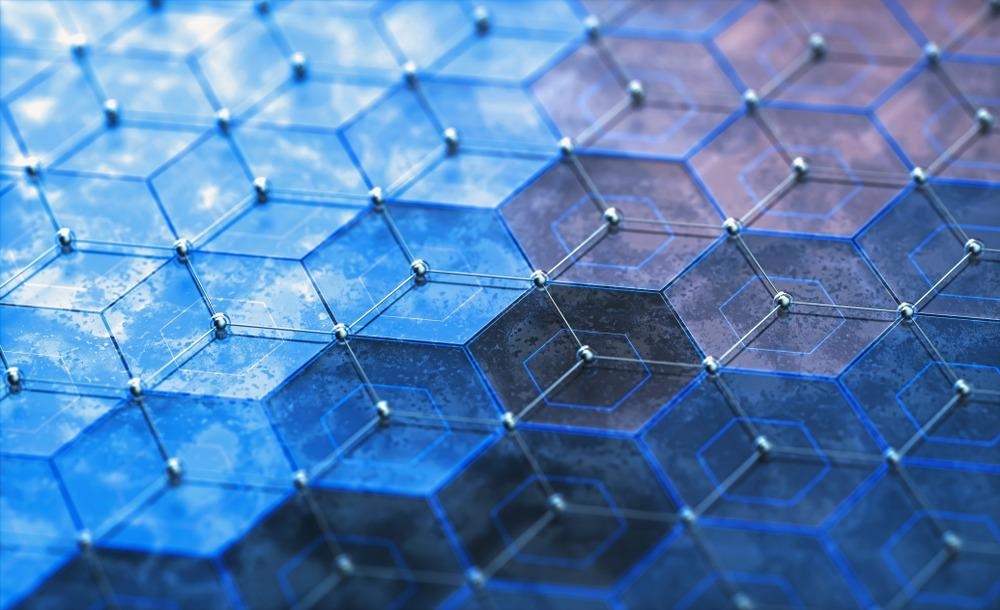AZoCleantech speaks to John Hartley, CEO at Levidian, about the importance of green graphene and hydrogen for accelerating climate-smart technology within our society. Hartley speaks about Levidian's rapid decarbonization device called LOOP and its massive potential in the sector.
Can you tell us briefly about your role at Levidian and what the company does?
I am the Chief Executive Officer at Levidian, a Cambridge-based climate-tech business that creates hydrogen and high-quality graphene from methane.
Why is it important that we find better ways to produce high-grade, low-cost green graphene and hydrogen?
In terms of graphene development, as a quick overview, graphene is a one-atom-thick layer of carbon, arranged in a honeycomb pattern. It is one of the thinnest and strongest materials ever discovered - 300x stronger than structural steel and 0.001% the weight of a sheet of paper of equivalent size.
Graphene can be added to many products – including tires, concrete, or paint – to make them more resistant, efficient, longer-lasting and therefore more environmentally friendly. To maximize these environmental benefits, we need to make high-quality graphene in a green way.

Image Credit: ktsdesign/Shutterstock.com
There are a few challenges – the current lack of standardization in the sector makes it difficult to determine product quality and track its manufacturing footprint. We are working with the UK Government to progress discussions on standardization.
Upscaling our national hydrogen capability is a clear priority - accentuated by the backdrop of the growing energy crisis. However, the current color categorization system for hydrogen - which focuses on method rather than footprint – could limit the ability of innovative companies to enter the market. By re-thinking the restrictive way we categorize hydrogen, we can allow new companies in the UK to develop ways to increase our capacity.
Can you explain what green graphene is and why it is important for our society?
Sustainable, or ‘green’ graphene, is graphene made through our plasma process. Normally, graphene is created through graphite exfoliation, a process that starts with mining graphite and has additional environmental impacts through the manufacturing process.
By contrast, Levidian’s rapid decarbonization device – LOOP - which I will go into in more detail below, captures methane that would otherwise be polluting our planet and uses this to create hydrogen – which can be incorporated back into the energy mix or stored for other uses – and our high-quality graphene.
This is vital because not only are we capturing methane and stripping it of its CO2 potential by up to 40%, but we are also creating one of the key building blocks of our future.
What is green hydrogen and why is it better to use than other forms of hydrogen?
Green hydrogen is the term applied to hydrogen produced via electrolysis, ideally using green electricity. The other form of hydrogen that people often discuss is blue hydrogen, which is the term applied to hydrogen produced via steam methane reformation with carbon capture, usage, and storage (CCUS). Steam methane reformation uses methane, but also requires steam. This is a carbon-intensive process, so it is only considered to have a low footprint if CCUS is applied.
This color categorization of hydrogen is simply shorthand – it does not actually reflect the carbon footprint of the hydrogen that is being produced. While green hydrogen may have a smaller footprint than blue, this depends on the source of electricity.
In our case, hydrogen produced via LOOP has a small carbon footprint. While our process does use methane and green electricity, the carbon is captured into graphene before it can be combusted into CO2. This process does not fit into the existing color categorization, except perhaps as ‘turquoise hydrogen.’ We are working to ensure that future classification of hydrogen is based on carbon footprint rather than method.
What is LOOP?
LOOP is a rapid decarbonization device that uses electromagnetic waves and a patented design to ionize methane (the molecule that makes up natural gas and one of the most damaging greenhouse gases) into a plasma. During this process, the methane is cracked into its component atoms: hydrogen and carbon.

Image Credit: Levidian
As explained above, the carbon is locked away in our high-quality graphene. Unlike other methane cracking processes, our LOOP technology does not apply heat or use any catalysts to work.
How is LOOP easily integrated with existing infrastructure?
Integrating LOOP is a relatively simple process. The mobile device can accept gas from a variety of sources and requires only a gas source and a power source. The graphene is collected within the device. Depending on the application, the post-process hydrogen-rich gas is either dropped back into the gas flow or run through a hydrogen separator to produce pure hydrogen. It is not quite as easy as plug-and-play, but it requires limited infrastructure changes in most cases.
What are the key benefits of using LOOP?
LOOP has a number of benefits. The first is that it allows for the decarbonization of methane, the primary molecule in natural gas, on-site and with minimal infrastructure requirement. For sectors such as heavy industry, achieving meaningful decarbonization is hugely challenging and LOOP provides a solution.
The graphene produced by LOOP can be used to improve the efficiency and sustainability of infrastructure and products, with the potential for significant decarbonization benefits in these applications. If we look at our partnership with National Grid as an example, they will be using graphene to reinforce parts of the gas pipe network from the inside by using graphene as a corrosion-resistant internal coating to prepare the grid for hydrogen.
In addition to the benefits I have mentioned, LOOP also produces hydrogen, which can either be dropped directly back into the energy supply or separated and stored for other uses. As we transition to a zero-carbon future, technologies that enable rapid decarbonization and hydrogen adoption offer real benefits.
How does LOOP assist with the United Nation’s Sustainable Development Goals?
There are many of the UN’s Sustainable Development Goals that LOOP can help accelerate. With the decarbonization of existing gas supplies, it goes without saying that it has direct relevance to Goal 7. It can also help rapidly decarbonize our heavy industry and construction, which has a direct correlation with Goal 9.
Graphene produced by LOOP could also have many applications supporting the SDGs. For example, graphene membranes with nanometer-sized pores have been developed for desalinating seawater and purifying drinking water, which is a direct benefit to Goal 6.
What kind of businesses can this device be used in?
Thanks to the ease of deployment and ability to dock with existing infrastructure, LOOP can be deployed across many sectors. A key focus for us is the decarbonization of heavy industry, which as you know is incredibly reliant on natural gas and, at the moment, there simply is not enough renewable resource or green hydrogen to allow them to make the switch.
Our key targets for LOOP include users of combined heat and power, anaerobic digestion sites, gas flaring sites, and other locations with large-scale methane usage.
What are Levidian’s next steps?
There are always exciting new projects going on at Levidian and the National Grid trial of LOOP is a great example. Current focus projects for us are to target getting gas as an input that would otherwise be vented into the atmosphere so we can help reduce high methane emissions.
Where can readers find more information?
Levidian’s press and news page with all of our new announcements can be found here. For any specific information please email [email protected].
About John Hartley
 I am Levidian’s CEO and prior to joining the team, I was Global Director of Product Management for Centrica, with accountability for bringing new, low-carbon technology to their global business customer base.
I am Levidian’s CEO and prior to joining the team, I was Global Director of Product Management for Centrica, with accountability for bringing new, low-carbon technology to their global business customer base.
While sitting on the Executive Leadership team for Centrica Business Solutions (CBS), I launched products including EV enablement, demand response (to enable a more renewable electricity grid), and battery storage. I helped CBS grow from a small team in 2015, to a business of more than £2bn in revenue in 2020.
Prior to this, I worked in strategy consulting, first at Accenture and then at McKinsey. My work has predominantly focused on the energy industry with commercial strategy and growth planning across Asia, Australia, and Europe.
Disclaimer: The views expressed here are those of the interviewee and do not necessarily represent the views of AZoM.com Limited (T/A) AZoNetwork, the owner and operator of this website. This disclaimer forms part of the Terms and Conditions of use of this website.